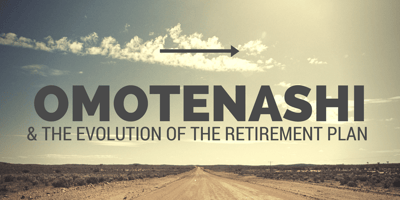Omotenashi is the Japanese word for treating people the way you'd want to be treated, for a posture of customer service that builds long-term trust and loyalty. Seth Godin, in one of his recent blog posts, discusses this concept as a service decision companies make to offer do-it-for-myself service rather than having the service being provided for the customer.
From Seth, "In a self-service world, the person who provides the service is us. We get what we want precisely because the system has been built to make us our own provider of service. This is why most people would rather order from a menu, pick our own travel itinerary or brush our own teeth. When done right, self-service is a great option to offer customers. When done to merely cut costs, or when done with a poor understanding of the user, it's mostly annoying."
The alternative, then, is to provide actual customer delight via service. To bring Omotenashi to the table, to offer human service that's even better than the customer could provide for herself.
One way to think about this is to consider our world of retirement plans. The early iteration of retirement plans featured the corporate pension plan where income for employees was guaranteed. With an increasing amount of retirees and a decreasing rate of return, pension plans became harder to sustain and a financial burden to the sponsoring companies. In a self-service world, an easier approach for organizations was to shift the burden of saving for retirement from their balance sheets to the employees. Unfortunately, when employees are the provider of service for their own retirement (they choose how much to save and how to invest) they have tended to make more decisions for today's lifestyle rather than tomorrow. According to a study by Vanguard , at the end of 2015 the median retirement plan account balance was $26,405. Employees have transitioned from an environment where their retirement received systematically funded and received professional money management to a system where employees make decisions by paycheck affordability and a risk tolerance quiz.

The next steps in the evolution of a retirement savings system are starting to think about bringing Omotenashi to the table. Smart defined contribution plan design looks to bring professional money management to employees through Target Date Funds. Retirement plan committees are beginning to think about the optimal savings rate of employees, and utilizing auto-enrollment and auto-escalation to increase employees' utilization of the plan. Employees routinely are questioning the viability of the Social Security system and are now awakening to the realization that they alone may be responsible for their retirement.
What more can be done to help employees save for retirement? Should more professional assistance be demanded of vendors such as recordkeepers, investment advisors, custodians, trustees? Today's employees are now demanding Omotenashi : If you're going to do it for us, do it beautifully.
To read more about Omotenashi Retirement Plan Investment Menu Design, consider downloading our free eBook by clicking the button below:
Other Readings you may enjoy:
3 Savvy Ways to Improve your 401(k) Investment Menu Design
Improving Plan Operation, Cost, & Investment Structure: A 401(k) Case Study
Top Rookie Mistakes When Evaluating your 401(k) & 403(b) Target Date Funds


